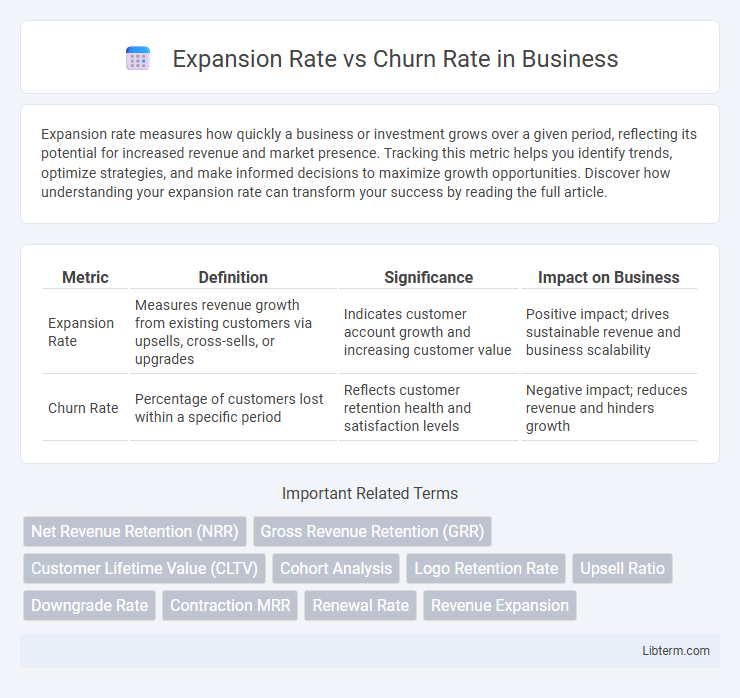Expansion rate measures how quickly a business or investment grows over a given period, reflecting its potential for increased revenue and market presence. Tracking this metric helps you identify trends, optimize strategies, and make informed decisions to maximize growth opportunities. Discover how understanding your expansion rate can transform your success by reading the full article.
Table of Comparison
| Metric | Definition | Significance | Impact on Business |
|---|---|---|---|
| Expansion Rate | Measures revenue growth from existing customers via upsells, cross-sells, or upgrades | Indicates customer account growth and increasing customer value | Positive impact; drives sustainable revenue and business scalability |
| Churn Rate | Percentage of customers lost within a specific period | Reflects customer retention health and satisfaction levels | Negative impact; reduces revenue and hinders growth |
Understanding Expansion Rate and Churn Rate
Expansion Rate measures the growth in existing customer revenue through upselling, cross-selling, and product adoption, reflecting the company's ability to increase value within its current user base. Churn Rate indicates the percentage of customers or revenue lost over a specific period due to cancellations or non-renewals, highlighting customer retention challenges. Understanding these metrics helps businesses balance growth strategies and retention efforts to maximize overall revenue sustainability.
Key Differences Between Expansion Rate and Churn Rate
Expansion Rate measures the percentage increase in recurring revenue from existing customers through upselling or cross-selling, reflecting business growth potential. Churn Rate indicates the percentage of customers or revenue lost over a period, highlighting retention challenges and revenue decline. Key differences include that Expansion Rate drives revenue growth within the current customer base, while Churn Rate signals customer attrition and negative revenue impact.
Why Expansion Rate Matters for SaaS Growth
Expansion rate measures revenue growth from existing customers through upselling and cross-selling, directly impacting SaaS company scalability. A high expansion rate offsets churn rate losses, ensuring customer lifetime value increases and driving sustainable revenue growth. Focusing on expansion rate enables SaaS businesses to maximize account potential, reduce dependency on acquiring new customers, and improve overall financial health.
The Impact of Churn Rate on Business Sustainability
High churn rate significantly undermines business sustainability by reducing the customer base and limiting revenue growth potential. A consistent churn rate above industry averages forces companies to invest more in customer acquisition just to maintain current revenue levels, weakening profitability. Monitoring and minimizing churn rate is crucial for maintaining steady expansion and long-term financial health.
Calculating Expansion Rate: Essential Metrics
Calculating Expansion Rate involves measuring the revenue growth from existing customers through upsells, cross-sells, and upgrades, providing insight into account growth beyond initial sales. Key metrics include Monthly Recurring Revenue (MRR) expansion, net revenue retention, and average revenue per user (ARPU) increases. Monitoring these metrics enables businesses to maximize customer lifetime value and offset churn rate impacts effectively.
Measuring and Analyzing Churn Rate
Churn rate measures the percentage of customers lost during a specific period, providing critical insights into customer retention challenges. Accurate calculation involves tracking active users at the start and end of the period while excluding new customers, enabling precise identification of churn patterns. Analyzing churn rate alongside expansion rate reveals growth dynamics and highlights areas requiring strategic intervention to enhance overall revenue stability.
Strategies to Boost Expansion Rate
Increasing expansion rate involves strategies such as upselling premium features, cross-selling complementary products, and enhancing customer success initiatives to drive higher usage and renewals. Analyzing customer usage patterns and tailoring personalized offers based on those insights can maximize revenue growth from existing customers. Implementing loyalty programs and continuous engagement through value-added content further incentivizes customers to expand their subscriptions or spend more.
Proven Methods to Reduce Churn Rate
Proven methods to reduce churn rate include improving customer onboarding, providing personalized support, and leveraging data analytics to identify at-risk customers early. Companies using proactive engagement strategies and loyalty programs report higher retention and increased expansion rates. Combining churn reduction techniques with upselling opportunities effectively boosts overall customer lifetime value.
Balancing Expansion Rate and Churn Rate for Profitability
Maintaining a healthy balance between expansion rate and churn rate is crucial for SaaS profitability, as a high expansion rate increases customer lifetime value while minimizing revenue loss from churn. Companies targeting a net revenue retention rate above 100% effectively leverage upselling and cross-selling to offset cancellations and contractions. Optimizing this balance ensures sustainable growth by maximizing recurring revenue without incurring excessive acquisition costs.
Real-World Examples: Expansion Rate vs Churn Rate in Action
Netflix demonstrates a high expansion rate by increasing revenue from existing subscribers through personalized content recommendations and tiered pricing, while maintaining low churn rates by consistently enhancing user experience. In contrast, telecom companies like Verizon often face challenges balancing churn due to competitive pricing pressures, even as they drive expansion via upselling data plans and premium services. SaaS platforms such as Salesforce optimize growth by minimizing churn through customer success initiatives while maximizing expansion rate via cross-selling and feature adoption campaigns.
Expansion Rate Infographic

 libterm.com
libterm.com